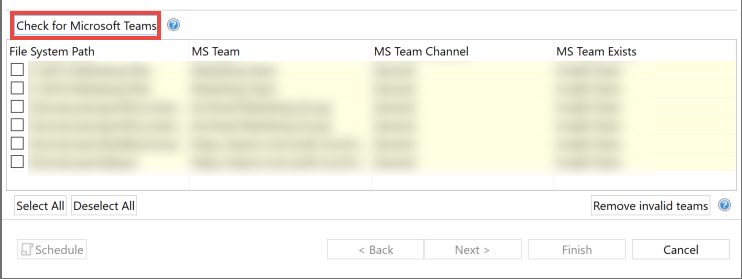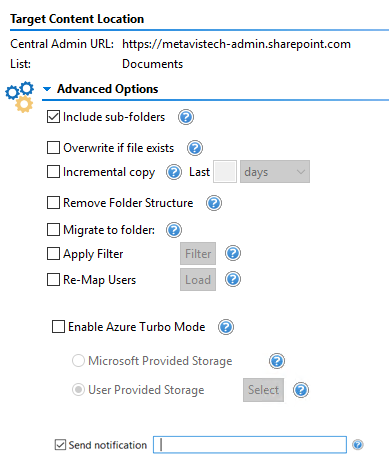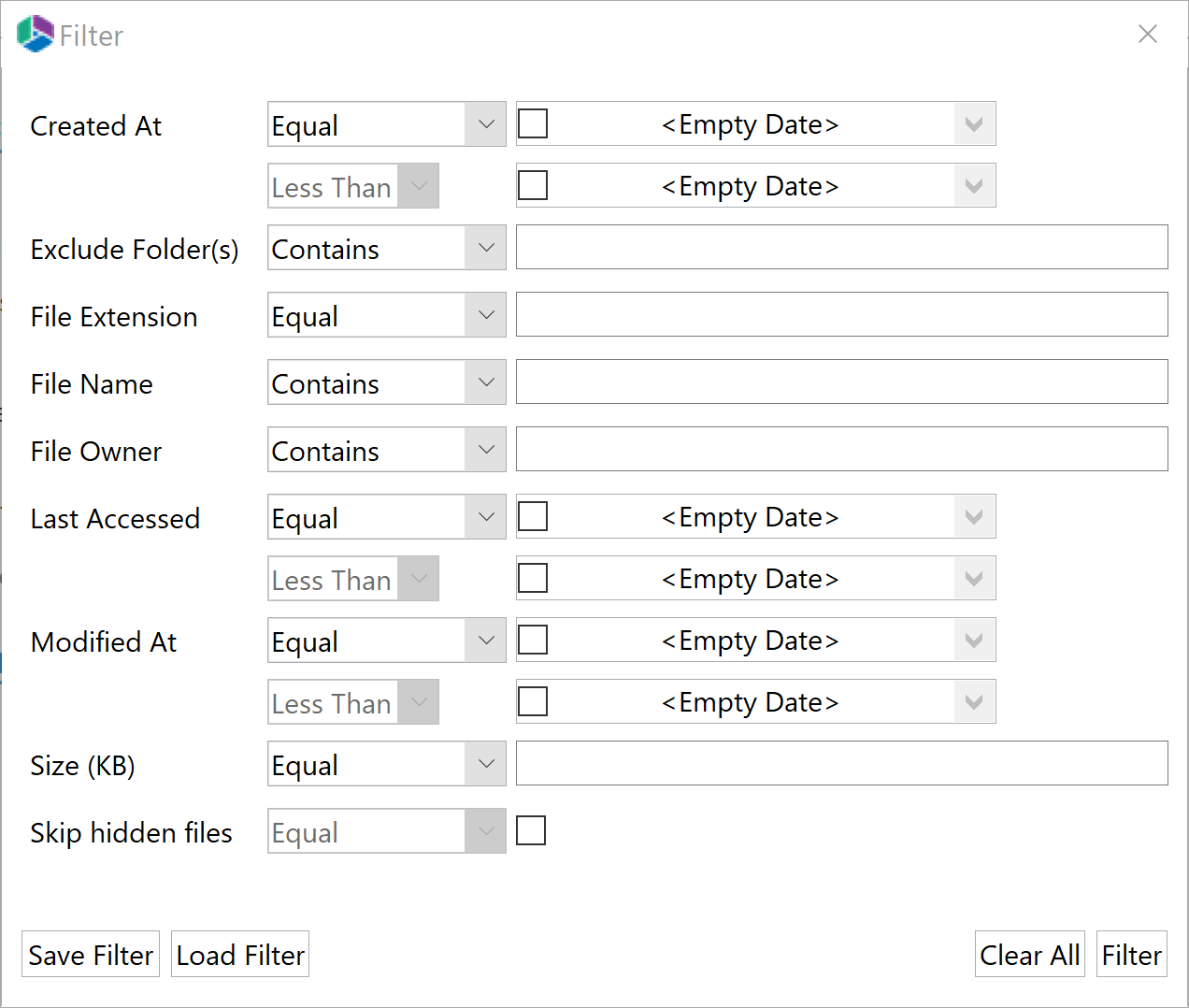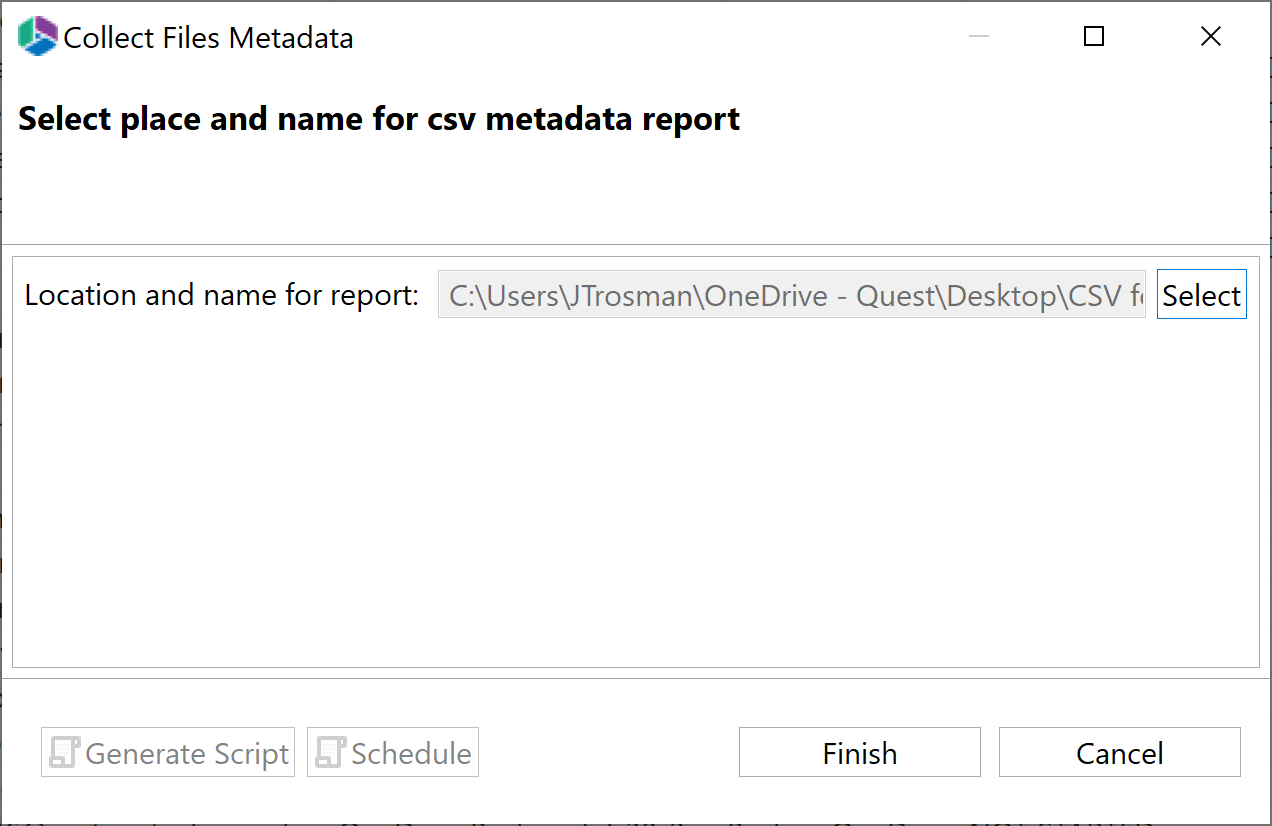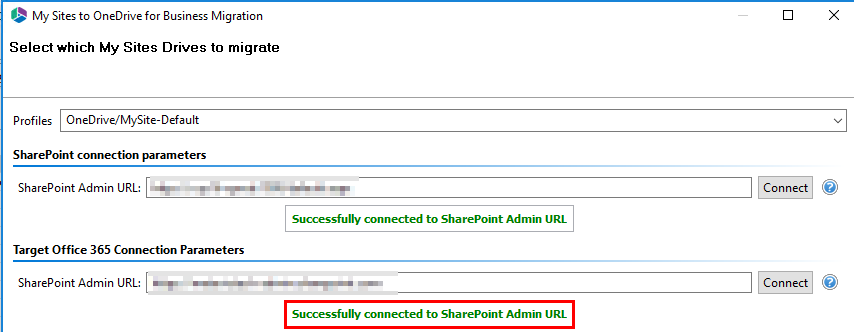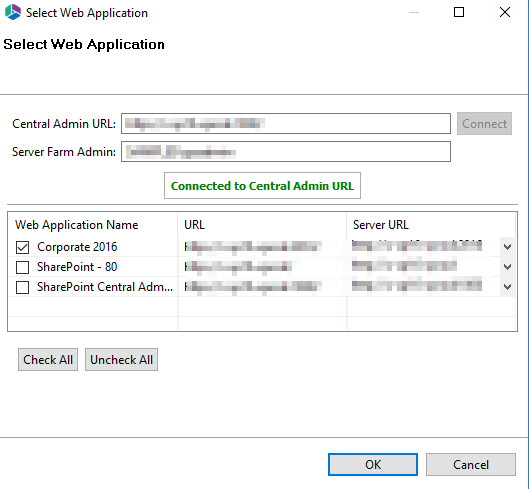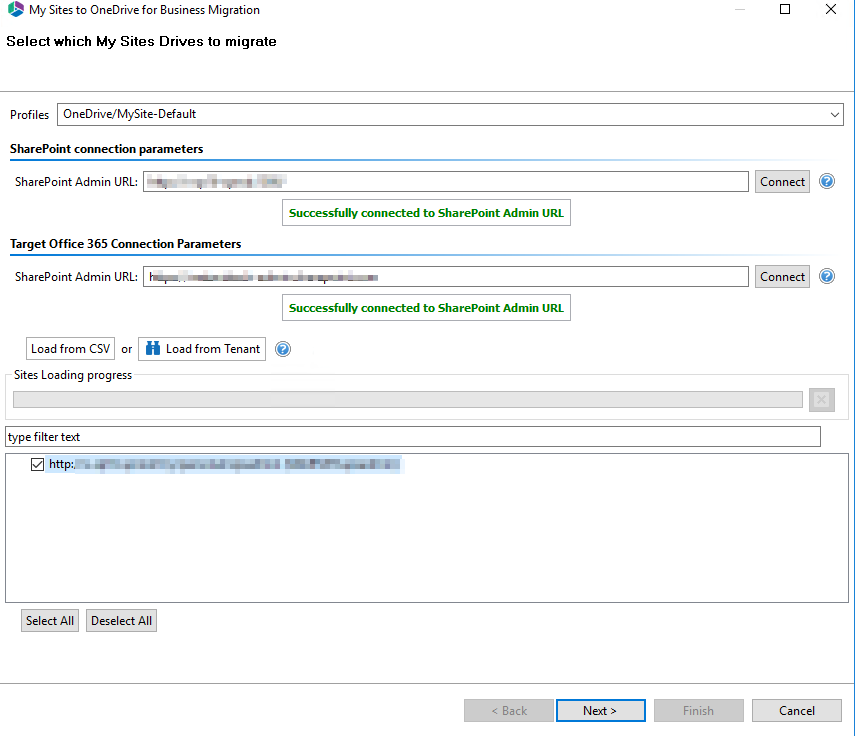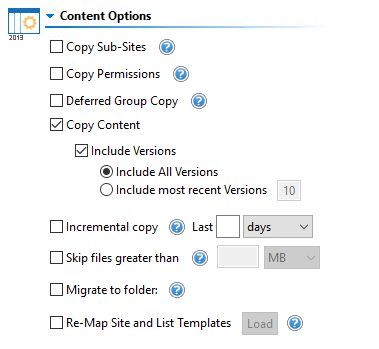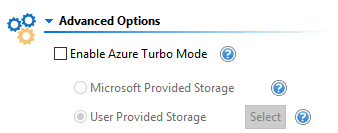Copy File Share to Microsoft Teams
This option provides the ability to bulk upload networked file system content into an Microsoft Team File Library.
This operation has the following requirements for use:
·The account used to perform the upload needs to have access and at least Read permissions from this computer to all the networked file system drives.
·The account used to perform the upload needs to be at least a Site Collection Administrator in this Office 365 tenant.
·The person performing the upload will need to know the relationship (user mapping) between each networked file system path and the corresponding Microsoft Teams Name.
·The Microsoft Team must already exist.
Once the requirements above are satisfied, you can proceed with your File Share to Office 365 Group Site migration.
1.Switch to the Drives tab and click the Copy File Share dropdown and then the "Copy File Shares to Microsoft Teams" migration button.
2.Give your project a name.
3.Enter the URL to the SharePoint Admin Center in your Office 365 tenant. Click the Connect button and then enter the Username and Password of your Administrator to authenticate. The SharePoint Admin Center URL will look similar to this: https://YourTenant-admin.sharepoint.com
4.In the Map File System to Groups section, load the file that maps the relationship between the networked file system drives and the corresponding Microsoft Teams. During upload all the content, files, and sub-folders (if configured), will be migrated from within the root of this network path and uploaded into the Microsoft Teams channel.
Click here to download an example mapping file.
Users can also choose to map to a MS Team Channel by adding a third column to the CSV mapping file. The format would be as follows:
\\home\users\blauer,Worldwide Sales,TeamsChannel
|
|
NOTE: When using the Teams Channel, keep the following in mind: ·When adding a Teams Channel to your CSV be sure to enter the name exactly it is case sensitive. If the name is entered improperly Essentials will assume it is a folder and will create a folder with this name on the target site collection. ·When the channel column is missing in the mapping then the migration will use the General channel by default. ·When the channel is missing on the target, then a folder will be created with the channel's name in the Shared Documents section of MS Teams. |
5.After the mapping file is loaded, click the Check for Microsoft Teams button to run a validation test. This option is designed to validate the existence of the mapped user in Microsoft Teams and also to check for the availability of each Team.
The following results can be displayed in the "MS Team Exists" column:
·Yes - The Group has been found in this Office 365 Tenant and this Group's Site has already been provisioned.
·No - The Group has been found in this Office 365 Tenant, but this Group's Site has not yet been provisioned.
·Invalid Group - The Group was not found in this Office 365 Tenant and therefore cannot be included with this operation as currently mapped.
After the validation process, select from the all the valid mappings from the list to include in this operation and click Next to continue.
6.If required, modify your Content Option settings as described below.
Include sub-folders - When enabled, this option will include the root folder and all sub-folders in the defined source path. When disabled, only the root folder will be included in the migration.
Overwrite if file exists - If the content already exists in the destination location, this option determines whether the operation will overwrite this content in the destination or to skip it.
Incremental Copy - When enabled, the migration process will identify and migrate only that content which was created or modified within the defined interval (days, weeks or months).
Remove Folder Structure - Enable this option to exclude all source folder structure. All folder content will be migrated into the destination location without their parent folders.
Migrate to Folder - When this option is enabled, you can create a (or use an existing) root folder structure in the destination library where your source content will be migrated. You will need to define the path like this example:
/My Source Content/2017
In the above example, the folder "My Source Content" and subfolder "2017" will be created in the root library of your destination and all source content will be migrated to this folder location.
|
|
NOTE: The 'Migrate to folder' option can be used when migrating to a MS Teams Channel. This option will create a new sub-folder in the channel or use an existing sub-folder by this name. |
Apply Filter - Optionally, select from a series of filterable parameters to include or exclude specific content during migration.
Note: the Apply Filter functionality is only applied to selected containers (i.e. site, lists or folders). If you select specific content (documents or items) then those objects will be included with the operation regardless of the filter applied. If you want to selectively include content, please select the container that this content resides in and apply the filter or apply the filter against the container first, then select the remaining content.
For the File Extension and Exclude Folders parameters only, you can use "," to set more than 1 criteria. For example, use this format "png,docx,pptx" to include multiple file extensions.
"Size" filter should have a whole number without decimals. It is recommended that users not use the operators "Equal" and "Not Equal" to avoid difficulties with accurate file size, if the file size is greater than 1 MB.
Use the "Save Filter" option to save filter settings to a file and load them in different wizards or the Profile Manager.
Re-Map Users - If necessary, create and load a user mapping file to be used for both permissions and metadata. User accounts as well as domain groups should be included in this CSV mapping file.
Enable Azure Turbo Mode: When enabled, this option utilizes Microsoft's SharePoint Online Migration API to increase the migration performance and throughput. A recommendation for optimal use of this API is larger sets of data; the more content, the better the throughput. Please review the User Manual for additional information as well as recommended configuration as this process is a resource intensive operation.
Because this API uses Azure storage as a staging area for the migration, it requires that you provide an Azure storage location. The options are to either utilize Microsoft supplied storage or to provide your own Azure storage location. If you wish to use your own Azure account, you must provide both the Azure Account Name as well as the corresponding Acces Key. If you cannot supply this information, please search our online Knowledge Base, User Manual or contact Support for additional information before proceeding or consider using the Microsoft Supplied Storage option. For more information please see the Azure Turbo Mode section.
|
|
NOTE: this function is optional and is only used to increase the migration performance to SharePoint Online or OneDrive for Business in Office 365. It does not provide any additional functionality that is not available when this option is disabled. |
·Microsoft Provided Storage: This option allows you to use Microsoft provided Azure storage instead of providing your own for the purpose of utilizing Azure Turbo Mode.
·User Provided Storage: This option allows you to provide your own Azure Storage instead of using one provided by Microsoft for the purpose of utilizing Azure Turbo Mode. It requires that you provide both your Azure Blob Storage Account Name as well as its corresponding Access Key by clicking the "Select" button to the right. If you cannot supply this information, please search our online Knowledge Base, User Manual or contact Support for additional information before proceeding.
|
|
NOTE: User Provided storage will give you access to Azure logs for a longer period of time than Microsoft provided storage. It will also allow you to perform the migration faster with less throttling. |
Send Notification: When selected, this feature will send emails to the listed recipients once Migrations are completed. Enter a specific user email address. For two or more, separate each email address with a comma. Set up User Notifications here in order to use this feature.
7.Click Finish to begin the migration.
Collect Files Metadata
Users can collect a csv report of a File's metadata using Essentials. This report can be used in migrations to help users determine what mappings they would like to use when migrating file shares.
To collect file metadata do the following:
1.In the Connections section, select the file for which you wish to collect metadata and right click. Select Collect Files Metadata from the drop down list.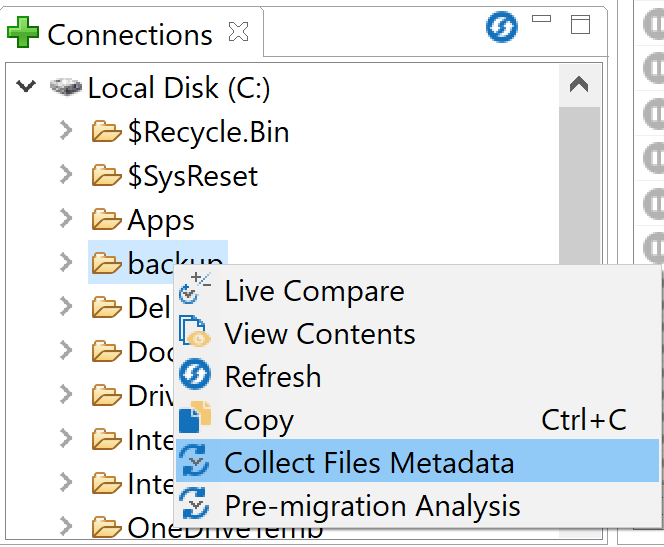
2.Click Select to assign a name and location for the report.
3.Click Finish to complete generating the report.
Copy My Sites to OneDrive for Business
A simple, Administrator driven wizard is provided to bulk migrate the lists and content from legacy on-premise SharePoint My Sites to OneDrive for Business sites in Office 365. In order to successfully configure and run this operation, you will need to be able to authenticate against the on-premise Central Admin page with a Farm Admin account (full control to all My Sites) as well as a Global Administrator in the Office 365 tenant. A mapping file may also be needed in order to resolve the user accounts between the source and destination locations.
This operation has the following requirements for use:
·The account used to perform the migration needs to have at least Owner permissions to each users' My Site.
·The account used to perform the migration needs to be a minimum of Site Collection Administrator in this Office 365 tenant.
·The person performing the migration will need to know the relationship (mapping) between each user's My Site account and their corresponding Office 365 user account.
·Each user account must have either a SharePoint or OneDrive license assigned to it in Office 365.
Once the requirements above are satisfied, you can proceed with utilizing the bulk upload functionality.
1.Switch to the Drives tab in Essentials for Office 365 and click the button Copy My Sites to OneDrive, located in the ribbon.
2.When the wizard appears, begin by entering the SharePoint Admin URL - This will be the URL to the on-premise SharePoint Central Admin page that hosts the My Sites. Once the URL is entered, click the Connect button, enter a valid Farm Admin account and click Connect. When you receive a successful connection message proceed to the next parameter.
3.Enter the URL for the SharePoint Admin Center in Office 365. Once the URL is entered, click the Connect button, enter a valid Admin account and click Connect. Note: that the Claims option is not supported for this operation. When you receive a successful connection message proceed to the next step.
4.Click the Load from SharePoint button or Load From CSV. Note that Load from CSV will allow you to load users from a CSV file, which is the faster option as only the listed users are loaded.
Load from SharePoint will connect to your source Farm and retrieve a list of available web applications. From this list, select the web application that hosts your My Sites and click OK.
Load from CSV will allow you to load users from a CSV file. You can use the user mapping report option to create this CSV file.
The wizard will now load a list of available My Sites into the table. Depending on the amount of My Sites within this web application, this may be a time consuming operation.
5.Check the box next to each My Sites that you would like to include with this operation and then click Next.
6.On the second page of the wizard, if a user mapping file is required, check the box next to Re-Map Users and then load the mapping file (for more information on how to create a user mapping file please see the User Mapping section).
7.Click the Check for users personal sites button. This operation will verify that the user account listed in the mapping file was found in Office 365 and it will also determine if the user's OneDrive for Business site is currently provisioned.
§If the user is valid in Office 365 but does not currently have a OneDrive for Business site, please check the option labeled "Create personal sites for the selected users" which will instruct the software to provision the necessary sites.
9. Click Next to continue.
10.The final page provides a few options to configure how the content portion of the operation should be configured.
Content Options
Copy Sub-Sites - Enable this option to include all sub-sites of the current site in this operation. |
Copy Permissions - This option will enable the transfer of internally shared permissions from the source to OneDrive for Business. For source Google Drive migrations, this will include internally shared folder and item-level permissions. For source SharePoint My Site migrations, this will include internally shared site, list and item level permissions. For source Box migratons, this will include internally shared folder collaborators. For source Dropbox migrations, this will include internally shared folder permissions. Deferred Group Copy - Selecting Deferred Group Copy will only copy Permissions Groups that are used within the site(s) you are copying. Selecting Copy Site Groups will copy all Groups across the entire site collection. |
|
|
NOTE: 1.Using Deferred Group Copy can be time consuming and result in slower migration performance. 2.Copying Permissions Groups requires elevated privileges within SharePoint. |
Copy Content - enabling this option will copy all of the content from your My Sites to your OneDrive. You can further specify if you would like to include all versions of the content from your My Sites, or only the specified most recent versions.
Incremental Copy - Incremental or delta migrations are an important and powerful option for large or ongoing projects and migration validation. Once enabled this option will migrate new, modified or versioned content from the source to the destination, capturing changes made by users during the previous migration. The value entered into the "Last" field will limit the amount of content examined to the time period specified, starting at present time. To perform an incremental migration, enter the amount of time to include and select the appropriate time period in days, weeks or months. Incremental migration is designed to be used in scenarios where the destination is not being modifed. To perform a delta migration, enter zero in the field and select days as the time period. Delta migration is designed to be used in scenarios where both the source and destination may be modified during the course of the migration. Please note that a delta migration compares dates between source and destination to determine which content to include, so it will take more time to process than an incremental migration.
|
|
NOTE: The Overwrite if File Exists parameter will be disabled if this option is selected. |
Skip files greater than - When enabled, this option will skip any source files that are greater than the value specified (in MB or GB). An entry will be added to the post-migration log indicating which file(s) were skipped due to this configuration.
Migrate to folder - When this option is enabled, you can create a (or use an existing) root folder structure in the destination library where your source content will be migrated. You will need to define the path like this example:
/My Source Content/2017
In the above example, the folder "My Source Content" and subfolder "2017" will be created in the root library of your destination and all source content will be migrated to this folder location.
Re-Map Site and List Templates - This feature allows for the re-mapping of list or site templates. Download the Site and List Template Report. To do this:
1.Right click on a site in the Navigation View and go to Reports > SharePoint Site and Templates(csv). Alternatively choose the Reports Menu and then choose the Site and List Templates button on the ribbon. Enter a file name and select a location to download the CSV report, then select "Save".
2.Open and review the template report. Choose the Source Template ID and the Target Template ID you would like to Re-Map.
3.Create a new CSV file and insert the Source template ID into column A, and the Target template ID into Column B. Save the new CSV file.
4.During a copy operation, select Re-Map Site and List Templates, and then choose "Load". Select the new CSV file containing Source Template ID and Target Template ID. Once you are satisfied with your settings, press the "Next" button located at the bottom of the window to continue to the Summary window. Review your migration settings one more time and press the "Finish" button to initiate the operation.
Advanced Options
Enable Azure Turbo Mode: When enabled, this option utilizes Microsoft's SharePoint Online Migration API to increase the migration performance and throughput. A recommendation for optimal use of this API is larger sets of data; the more content, the better the throughput. Please review the User Manual for additional information as well as recommended configuration as this process is a resource intensive operation.
Because this API uses Azure storage as a staging area for the migration, it requires that you provide an Azure storage location. The options are to either utilize Microsoft supplied storage or to provide your own Azure storage location. If you wish to use your own Azure account, you must provide both the Azure Account Name as well as the corresponding Acces Key. If you cannot supply this information, please search our online Knowledge Base, User Manual or contact Support for additional information before proceeding or consider using the Microsoft Supplied Storage option. For more information please see the Azure Turbo Mode section.
|
|
NOTE: this function is optional and is only used to increase the migration performance to SharePoint Online or OneDrive for Business in Office 365. It does not provide any additional functionality that is not available when this option is disabled. |
·Microsoft Provided Storage: This option allows you to use Microsoft provided Azure storage instead of providing your own for the purpose of utilizing Azure Turbo Mode.
·User Provided Storage: This option allows you to provide your own Azure Storage instead of using one provided by Microsoft for the purpose of utilizing Azure Turbo Mode. It requires that you provide both your Azure Blob Storage Account Name as well as its corresponding Access Key by clicking the "Select" button to the right. If you cannot supply this information, please search our online Knowledge Base, User Manual or contact Support for additional information before proceeding.
|
|
NOTE: User Provided storage will give you access to Azure logs for a longer period of time than Microsoft provided storage. It will also allow you to perform the migration faster with less throttling. |
11. Click Finish to begin the migration.
Copy Tenant
Metalogix Essentials for Drives provides a simplified, wizard driven experience to migrating content in, out, or between various drive management systems (local or cloud based). It can also provide additional functionality to managing some or all OneDrive for Business sites within a specific Office 365 tenant.






